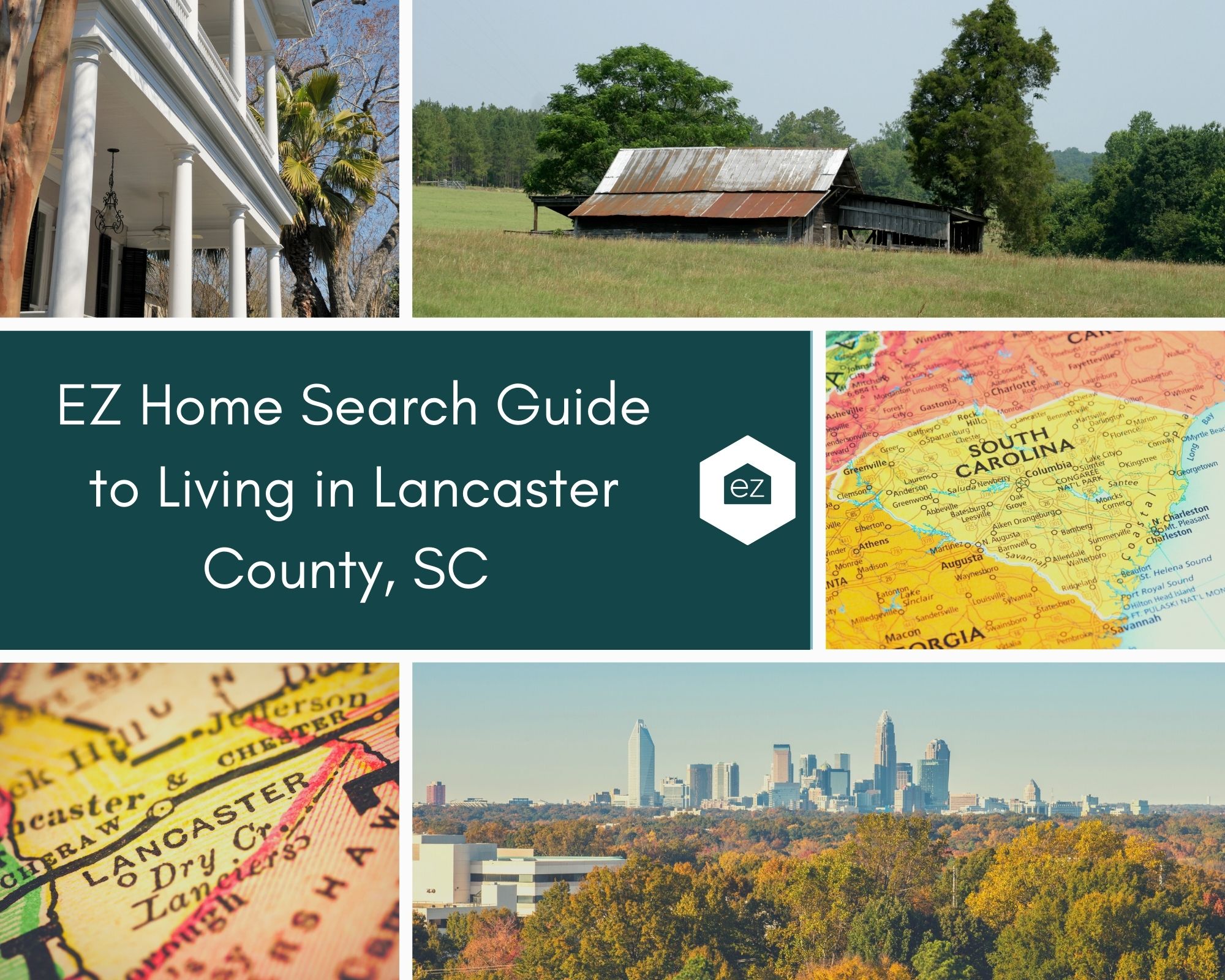EZ Home Search Guide to Living in Lancaster County, SC
EZ Home Search Guide to Living in Lancaster County, SC
Lancaster County is a land of opportunity. This slice of the Piedmont section in South Carolina has a mild climate, intrepid business spirit, and classic southern hospitality. It has a rich history dating back to our country’s founding; an American president was born and raised here.
Located optimally between two major metropolitan areas, Lancaster County residents enjoy small-town living while still being close to significant employers and transportation corridors. See what Lancaster County has to offer and if it’s the best place for you to live in South Carolina.
About Lancaster County
Lancaster County is in the northern region of South Carolina. Some consider it part of the Charlotte, North Carolina suburbs. It’s just 40 minutes south of this major destination. It’s also just 60 miles north of South Carolina’s capital, Columbia. The borders create an unusual shape, with a narrow strip of land forming an antenna-like “panhandle.” More development is apparent in this region, while the southern portions tend to be more rural and agricultural.
The county is surrounded by York, Chester, Fairfield, Chesterfield, and Kershaw counties. North Carolina forms its northern border. No major interstates run through Lancaster, but US 521 is an essential corridor for economic growth in the county.
Four rivers run through Lancaster County: the Catawba River, Little Lynches River, Lynches River, and Hanging Rock Creek. The Catawba and Lynches have been important regional resources for tourism and power.
Many areas of Lancaster County have historical significance. Various small towns have homes on the National Register of Historic Places.
Lancaster County has also been an essential provider for the region agriculturally and through mining. The Haile Gold Mine has produced a total value of $7 million and was the largest gold mine east of the Mississippi River.
Residents enjoy a reasonable cost of living. Based on the Cost of Living Index, where a score of 100 represents the US average, Lancaster County scored 87.1. Housing was its most affordable index, at 53.2.
Lancaster County History
The area today known as Lancaster County was initially inhabited by the Catawba and Waxhaw Native Americans. They were drawn into the area for its wildlife and natural bounties.
European settlement began in the early 1750s when Scots-Irish immigrants seeking religious freedom and cheap land moved into the area known as Waxhaws, today northern Lancaster County. A second colony was developed soon after by more European immigrants from Virginia, North Carolina, and Pennsylvania.
Lancaster was named for Lancaster County, Pennsylvania, where different immigrants had initially come from.
During the American Revolution, Buford’s Massacre took place ten miles east of the town of Lancaster. British forces killed or wounded almost all 350 Patriots of Colonel Abraham Buford’s retreating troops. A few months later, the travesty was avenged when Colonel Thomas Sumter surprised and defeated British forces at the Battle of Hanging Rock in the southern part of Lancaster County.
General William T. Sherman occupied the town of Lancaster on his way to Virginia during his Southern campaign in 1865. The Union Soldiers attempted to burn the courthouse and the jail, but the damage was not severe to either building. The soldiers did loot the town and used the Presbyterian Church as a stable for the horses.
During Reconstruction, the Springs Cotton Mill was founded and grew to become a large textile plant. The plant became vital to the fortunes of Lancaster and its citizens. The mill and its owners had tremendous local influence into the twentieth century.
Lancaster County Cities and Areas
The town of Lancaster serves as the county seat. It was named after the famous House of Lancaster and Pennsylvania’s Lancaster County, where many early European settlers emigrated from. The town is nicknamed the “Red Rose City,” after the House of Lancaster from The War of the Roses. Residents here have an independent spirit.
The town of Heath Springs is a small town to the south of Lancaster. It prides itself on its southern hospitality. The nearby Hanging Rock Mineral Spring was known for its healing springs during the 1850s. People came into the area seeking the healthful benefits of the mineral waters.
The town of Kershaw is shared between Lancaster and Kershaw counties. It is a vibrant small-town community that includes golf courses, bowling alleys, parks, community centers, and more amenities. Kershaw runs events and festivals, such as the Tailgate Festival and Wreaths Across America. Kershaw also has a farmer’s market.
The panhandle region is home to more economic development and manufacturing. It has proximity to Charlotte, North Carolina, and its suburbs. The southern area of Lancaster remains more rural, although the county is working to attract businesses along the US 521 corridor.
Lancaster County Job Market
The top employing industries in Lancaster County are retail trade, manufacturing, professional services, and administrative services.
Lancaster’s top employers based on their size include, but are not limited to, Cardinal Health, Continental Tire North America, Haile Gold Mine, Kanawha Insurance Company, Keeramerica, Medical University Of South Carolina, Movement Mortgage, Nutramax Manufacturing, The Budd Group, and TriNet USA.
Manufacturing represents around 14% of all the jobs available in Lancaster County. There are facilities for Cardinal Health, Keer America, Nutramax Laboratories, Oceanagold, PCI Group, and Rico Industries. There’s a range of manufacturing work available, from textiles to pharmaceuticals to metal fabrication.
The 2020 unemployment rate in Lancaster was 6.9%, slightly above the state rate but below the United States average. A decade ago, the unemployment rate was 14.9%, but this declined to 3.2% in 2019 before the pandemic.
Lancaster County’s unemployment rate as of June 2021 was 4.8%, near the state figure and under the United States average.
A Lancaster County Community profile projected that the job market would increase by 13.6% from 2016 to 2026, adding over 18,000 new jobs. The industries with the most anticipated growth were accommodation and food services, health care, wholesale trades, and transportation and warehousing.
Lancaster County Real Estate Market
The Piedmont Regional Association of Realtors services Lancaster County. It calls the area the Charlotte region. Drilling down into Lancaster County in June 2021, we see median sales prices have been rising since 2012.
Year-over-year, new listings were down 26%. The median sales price of a Lancaster County home was $385,000, an 11.6% increase. Sellers often received 102.2% of the original list price. The cumulative days on the market until the sale was 12, a 75% drop. The average number of days on the market until the sale was 14. The month’s supply of inventory was 0.6 months, almost two weeks.
Lancaster County property taxes reported an average effective property tax rate of 0.55%. The median home value was $182,400. Based on those figures, the average homeowner paid $1,003.20 in property taxes.
Lancaster County Population
The latest data puts the county’s residential population at 96,016 as of April 2020, a 20% growth in new residents. Historically, the number of people living in Lancaster County has grown since the 1970s, but the 2020 Census report exceeds the 2030 projection of 83,940.
Demographically, the age bracket with the most number of residents was the 45-to-49-year-old group. According to the US Census Bureau, the average age of a Lancaster County resident was 42.1 years old.
Around 74% of Lancaster County residents identified as white, and 24% identified as black. As of 2020, around 19% of the county residents had a bachelor’s degree or higher. Another 29% had some college education.
Lancaster County Education
The Lancaster County School District runs 13 elementary schools, five middle schools, and four high schools. There is an additional career center, adult education, and early childhood center. Around 14,000 students attend the public schools. Top-ranked schools include Indian Land High School, Harrisburg Elementary School, and Andrew Jackson High School.
Lancaster County residents have one K-12 private school to choose from, Carolina Christian Academy.
Higher education is available at The University of South Carolina- Lancaster. It is one of the four regional state colleges in the University of South Carolina system. USC Lancaster offers associate’s and bachelor’s degree programs.
Lancaster County Health Care
MUSC Health Lancaster Medical Center is the leading healthcare provider in the county. Its 156-bed facility offers acute care, diagnostic services, women’s health, emergency treatment, wound care, orthopedic services, cardiac services, and more.
Rebound Behavioral Health Hospital is an adult in-patient treatment center and substance abuse rehab program. It has 63 beds on its peaceful, wooded estate.
Lancaster County Things To Do
Much of what makes Lancaster County an attractive place to live has to do with its natural resources. It’s rich in history, was the birthplace of an American president, and is the scene of some significant American Revolutionary War battles.
Naturally, there’s plenty of historical sites to visit. Andrew Jackson State Park in Lancaster combines history and outdoor recreation, making it a popular park. A museum and interactive exhibits chronicle Andrew Jackson’s early years in the South Carolina backcountry. There’s also a replica schoolhouse, campground, fishing lake, and nature trails.
Forty Acre Rock is the highest point in Lancaster County, South Carolina. The hiking trail here offers some fantastic views and a specialized environment that is unique in the Piedmont Region.
The Catawba River is a significant watershed for South Carolina. It’s named after the Catawba tribe, which lived on its banks. In Lancaster County, it runs into Fishing Creek Reservoir near Great Falls. Access the river and its reservoir for fishing and water recreation.
More lakes, such as the Lancaster Reservoir and Lake Wateree, offer fishing for largemouth bass, bluegill, red ear sunfish, and catfish. Lake Wateree’s uppermost reaches form the southeastern corner of Lancaster county; in sum, it has 13,800 acres available for water recreation.
Two golf courses are available in Lancaster County: Edgewater Golf Club and Lancaster Golf Club. Edgewater is called a “Hidden Gem in South Carolina” and ranked as one of the hardest courses in the Charlotte area by the Charlotte Business Journal.
You can pick up a map for a walking tour of downtown Lancaster’s historic district or a driving tour of the historic sites from the Chamber of Commerce.
The Red Rose Festival in Lancaster is an award-winning weekend event with live music, arts and crafts, children’s activities, a dog show, and more. The city also hosts other events around the holidays, such as a May 4th event, Easter, Halloween, and Thanksgiving festivals.
Lancaster County Local Attractions
Visit the Buford Battle Ground and gravesite, a historical site from the American Revolution. Even though the Patriots waved a white flag of surrender, they were either killed or wounded by British forces. The Daughters of the American Revolution have erected a monument at the site.
The Forty Acre Rock Heritage preserve is almost 3,000 acres of protected area in the Piedmont Region. It features granite flat rocks, water slides, waterfalls, caves, and hardwood forests. There is a two-mile out and back trailhead.
The Lindsay Pettus Greenway connects two miles of downtown Lancaster and many different businesses and neighborhoods. The expansion is ongoing, but it is a paved walking and biking trail that is a segment of the Carolina Thread Trail.
Lancaster also has cultural attractions such as the Lancaster Cultural Arts District, the Community Playhouse, which hosts local and some traveling acts, and the Native American Studies Center, a resource for studying and preserving Native American culture.
The Hall Family Farm is a local favorite. Stop by to pick strawberries in the spring or pumpkins in the fall. There’s also a corn maze and other family events throughout the year.
Lancaster County Dining
Residents have a range of dining options. Southern-style cuisine is popular in the different communities, but you can still find restaurants that serve Mexican, Asian style, or classic American fare. Here’s a sampling of what’s available in the region:
- Jomar’s Family Restaurant offers a variety of different foods served buffet and sit-down style.
- Sambo’s 903 Drive-In, a diner destination for over 50 years serving burgers and hot dogs
- Leigh Anne’s Restaurant, serving southern-style breakfast and lunch since 1980
- Benford Brewing, a one-of-a-kind agricultural brewery destination with craft beer and farmhouse fun.
- 521 BBQ and Grill in Indian Land rubs its Boston butts with signature spices and is smoked for 14 hours on site.
- Charley’s Cafe specializes in American and South Carolina Lowcountry cuisine.
Lancaster County Shopping
The town of Lancaster has a downtown area with local shops selling unique retail wares and providing services to area residents. The town actually runs a website that lists all the possible shopping venues, from the local to smaller retail chains.
Visit The Shops on Main Street in Lancaster, a multi-vendor antique and local artist mall for a unique shopping destination. Here you’ll also find handcrafted furniture, rare finds, and home decor.
Lancaster Farmers Market opens in May and runs through December. Throughout the summer, and operates on Tuesdays, Thursdays, and Saturdays. The town of Kershaw also has a farmers market that runs on Saturdays during the warmer months of the year.
Living in Lancaster County
Residents enjoy the different amenities of Lancaster County. Its location in the Upcountry region places it close to the larger metropolitan areas in South Carolina and North Carolina. It’s also relatively close to the Appalachian Mountains and not a far drive from the Atlantic beaches. While living close to these big city centers and the employment opportunities they provide, residents still have an affordable cost of living and enjoy a small-town lifestyle. It’s no wonder Lancaster County is growing by leaps and bounds.
Start Your Home Search
Preston Guyton
Share this Post
Related Articles
Living In
Your EZ Guide to Living In Salisbury, MD
Living In






